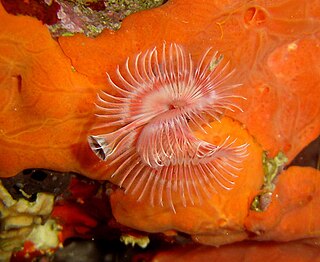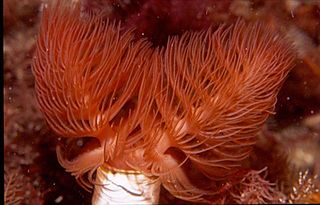Related Research Articles

Dry rot is wood decay caused by certain species of fungi that digest parts of the wood which give the wood strength and stiffness. It was previously used to describe any decay of cured wood in ships and buildings by a fungus which resulted in a darkly colored deteriorated and cracked condition.

Serpula lacrymans is one of the fungi that cause damage to timber referred to as dry rot. It is a basidiomycete in the order Boletales. The Serpula lacrymans has the ability to rapidly colonise sites through unique and highly specialised mycelium which also leads to greater degradation rates of wood cellulose.
The Cosmopterigidae are a family of insects in the order Lepidoptera. These are small moths with narrow wings whose tiny larvae feed internally on the leaves, seeds, stems, etc. of their host plants. About 1500 species are described. The taxonomic family is most diverse in the Australian and Pacific region with about 780 species.

The Serpulidae are a family of sessile, tube-building annelid worms in the class Polychaeta. The members of this family differ from other sabellid tube worms in that they have a specialized operculum that blocks the entrance of their tubes when they withdraw into the tubes. In addition, serpulids secrete tubes of calcium carbonate. Serpulids are the most important biomineralizers among annelids. About 300 species in the family Serpulidae are known, all but one of which live in saline waters. The earliest serpulids are known from the Permian.
Rhadinastis is a genus of moth in the family Cosmopterigidae.

Serpula is a genus of sessile, marine annelid tube worms that belongs to the family Serpulidae. Serpulid worms are very similar to tube worms of the closely related sabellid family, except that the former possess a cartilaginous operculum that occludes the entrance to their protective tube after the animal has withdrawn into it. The most distinctive feature of worms of the genus Serpula is their colorful fan-shaped "crown". The crown, used by these animals for respiration and alimentation, is the structure that is most commonly seen by scuba divers and other casual observers.
In 1758, in the 10th edition of Systema Naturae, the Swedish scientist and taxonomist Carl Linnaeus described the class "Vermes" as:
Animals of slow motion, soft substance, able to increase their bulk and restore parts which have been destroyed, extremely tenacious of life, and the inhabitants of moist places. Many of them are without a distinct head, and most of them without feet. They are principally distinguished by their tentacles. By the Ancients they were not improperly called imperfect animals, as being destitute of ears, nose, head, eyes and legs; and are therefore totally distinct from Insects.

Serpula is a genus of fungi in the family Serpulaceae.

Serpula vermicularis, known by common names including the calcareous tubeworm, fan worm, plume worm or red tube worm, is a species of segmented marine polychaete worm in the family Serpulidae. It is the type species of the genus Serpula and was first described by Carl Linnaeus in his 1767 12th edition of Systema Naturae. It lives in a tube into which it can retract.
Kuphus is a genus of shipworms, marine bivalve molluscs in the family Teredinidae. While there are four extinct species in the genus, the only extant species is Kuphus polythalamius. It is the longest bivalve mollusc in the world, where the only known permanent natural habitat is Kalamansig, Sultan Kudarat in the Philippines.

Pulvinic acids are natural chemical pigments found in some lichens, derived biosynthetically from the aromatic amino acids phenylalanine and tyrosine, via dimerization and oxidative ring-cleavage of arylpyruvic acids, a process that also produces the related pulvinones.

Serpula himantioides is a species of fungus that causes damage to timber referred to as dry rot. It is a basidiomycete in the order Boletales. It has been found on all continents except for Antarctica. Recent molecular work demonstrates that S. himantioides is a species complex including multiple cryptic lineages.

Protula bispiralis, commonly known as the red fanworm or as a mopworm, is a species of marine polychaete worm in the family Serpulidae.
Rhadinastis loraria is a moth in the family Cosmopterigidae. It was described by Edward Meyrick in 1917. It is found in India.
Rhadinastis melitocosma is a moth in the family Cosmopterigidae. It was described by Edward Meyrick in 1931. It is found in India.
Rhadinastis microlychna is a moth in the family Cosmopterigidae. It was described by Edward Meyrick in 1897. It is found in Australia, where it has been recorded from New South Wales.
Rhadinastis phoenicopa is a moth in the family Cosmopterigidae. It was described by Edward Meyrick in 1907. It is found in Sri Lanka.
Rhadinastis sideropa is a moth in the family Cosmopterigidae. It was described by Edward Meyrick in 1897. It is found in Australia, where it has been recorded from Tasmania.
References
- ↑ Beccaloni, G.; Scoble, M.; Kitching, I.; Simonsen, T.; Robinson, G.; Pitkin, B.; Hine, A.; Lyal, C., eds. (2003). "Rhadinastis serpula". The Global Lepidoptera Names Index . Natural History Museum . Retrieved May 13, 2018.
| This article relating to Cosmopteriginae is a stub. You can help Wikipedia by expanding it. |